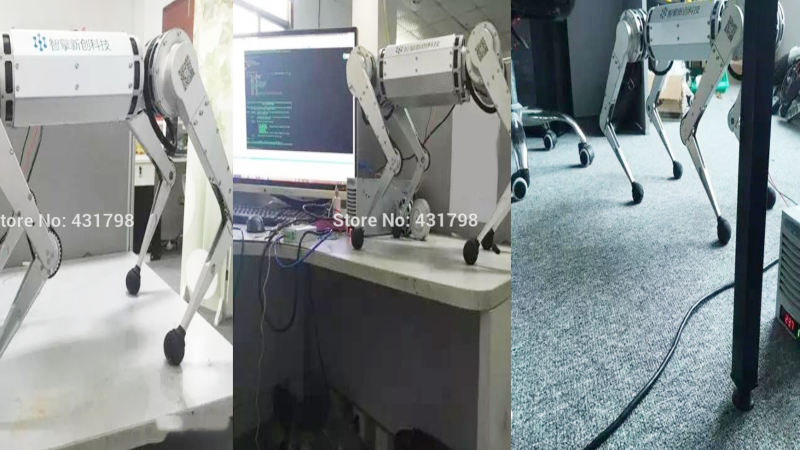We nearly passed over this tip from [xoxu] which was just a few links to some AliExpress pages. However, when we dug a bit into the pages we found something pretty surprising. Somewhere out there in the wild we…east of China there’s a company not only reverse engineering the Mini Cheetah, but improving it too.
We cover a lot of Mini Cheetah projects; it’s a small robot that can do a back-flip after all. When compared to the servo quadruped of not so many years ago it’s definitely exciting magic. Many of the projects go into detail about the control boards and motor modifications required to build a Mini Cheetah of your own. So we were especially interested to discover that this AliExpress seller has gone through the trouble of not just reverse engineering the design, but also improving on it. Claiming their motors are thinner and more dust resistant than what they’ve seen from MIT.
To be honest, we’re not sure what we’re looking at. It’s kind of cool that we live in a world where a video of a research project and some papers can turn into a $12k robot you can buy right now. Let us know what you think after the break.
















The page states right up front that “Please note: This product is a custom-made product with no quality problems. Once sold, it will not be returned!”
And you guys know well enough that any complex custom assembly is bound to have issues. Basically, each one is it’s own prototype!
No thanks, and especially not for a non-refundable $12,728!
$12K is nothing for a VC funded startup if it means you can shortcut mechanical design and jump straight into magic AI machine learning powered by blockchains mobility algorithms.
Please tell us more if you had the opportunity to work with one of these units at work, I’d love to know how much reverse-engineering is eliminated with something from aliexpress that isn’t branded. I’m kind of being a sarcastic ass but I trust my point sustains that it may require a good ol’ teardown before you get it to a research level platform, which could be its own Wild West if anything like my working experience had retrofitting with fringe tech from China.(sarcasm meant in all in good fun of course)
Considering the robot needs software/firmware to operate,
I have no desire to put one of these in my house/yard.
“Just download this app onto your smartphone!”
Dont get too excited or saddled on that high horse… I heard that all they did was read his thesis which anyone can do here: https://dspace.mit.edu/handle/1721.1/118671
SPOT – Boston Dynamics – https://www.bostondynamics.com
It’s made of Finest Quality™ Chinesium® alloys. What could possibly go wrong?
Simultaneously brittle and soft! A true material science breakthrough!
If I buy any device for $12,000, I darn well better be able to drive it on the highway or live in it! (I didn’t pay much more than that for my 1st home!)
Logos on that machine are the same as for Chinese battery manufacturer Pylontech
Was that home bought 1950 or is it a shack in the woods?
Based on previous posts likely 1950.
Reverse engineering or copying? Plenty of Chinese students at MIT, takes just one to copy design files. No videos means the only copied mechanical parts and are struggling with software?
It isn’t “reverse engineering” unless they have their hands on the actual bot and works backwards.
Research papers are published and there is even a github for the software.
https://github.com/mit-biomimetics/Cheetah-Software
under MIT License
>Permission is hereby granted, free of charge, to any person obtaining a copy
of this software and associated documentation files (the “Software”), to deal
in the Software without restriction, including without limitation the rights
to use, copy, modify, merge, publish, distribute, sublicense, and/or sell
copies of the Software, and to permit persons to whom the Software is
furnished to do so, subject to the following conditions:
yada yada…
Guys it only cost $50 the rest are Trump’s tariffs.
It is a bold claim to say it has been “improved” in China, if the versions from China cannot even take a single step yet, even though all the MIT software is publicly released. It seems like it is a failed attempt to copy, rather than an improvement.
Bingo. Obviously, someone ‘phoned home’ with the design. It is time to get the spies out of our US university system. Bye, bye.
I actually bought the 2 actuators that the manufacturer sells – their “improved” V2 version. Apart from the hardware (BLDC motor and gearbox) it is total crap. The motor driver control board is useless. It is nowhere near what Katz has done on the mini Cheetah. The control is a simple VESC with a position controller on top. Depending on the actuator, it can use anything from 1A going in one direction, and 15A going in the opposite. It’s not even possible to tune the damn thing to make it usable. The documentation is scarce, you don’t even get a full register table! After some reverse engineering of their windows software, I was able to identify most of the registers. Funny thing, before I did that, using the provided documentation I was able to brick one of the drivers just by switching from position control to velocity control. The motor doesn’t always respond with a packet as the documentation shows.
In short, STAY AWAY.
Thanks for the evaluation Greg, I am considering buying them myself. How is the control board (MOSFET, current sensor, etc) itself? I am planning to run my own firmware anyway, so as long as the HW itself is good, I don’t mind. Is the MCU still what Ben Katz used (STM32F466RE)?
Damn this is somewhat sad. I was hoping to use some of these motors for a project.
Are there any commercially available version of these motors for sale other than aliexpress?
Take heart Jonathan. https://store.tmotor.com/category.php?id=97